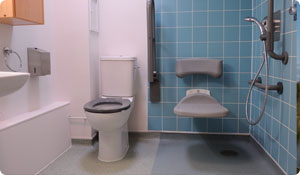
Anyone can get hurt stepping in and out of the shower and lifting up and down in the tub but the elderly and people with impaired mobility are especially vulnerable. Falling on wet, hard, surfaces can cause real, physical damage that can sometimes be fatal. The Centers for Disease Control and Prevention say each year more than 234,000 non-fatal injuries occur in the bathroom.
Patrice Winter, physical therapist, spokesperson for the American Physical Therapy Association and faculty member in the Rehabilitative Medicine Department at George Mason University in Fairfax, Virginia says many bathroom accidents can be prevented by installing adaptive equipment and learning some safety techniques. "Maneuvering while washing up requires muscle strength and control," says Winter explaining why showering is safer than bathing. "Most people with impaired mobility just aren't strong enough to lower their bodies to a sitting position for a tub bath and lift back up and out again." She offers these bathroom safety tips:
Remodel for Safety
"The best bathroom has a large door wide enough to accommodate a wheelchair plus a walk-in—or wheel-in-shower. The second-best option is a shower with a three-to four-inch lip that's easy to step over.
For those who can't afford to remodel, adapt your existing bathroom with:
Grab bars on the shower walls so you can hold on while you step over the side of the tub or into the shower. To stop slips, apply strips of adhesive decals on the shower or bathtub floor and keep a nonskid rug on the floor next to the shower/bath exit.
If you're able to step in to the tub or shower, a stable, plastic bath bench or seat with non-skid feet gives you somewhere to rest or sit while showering. If you can't stand or step in, a bath bench that fits over the side of the tub or extends outside the shower allows you to transfer from your chair to the bench, then slide into the tub or shower.
The right hand-held showerhead or one on a vertical pole that can be lowered makes it easier to get water spray all over your body. "A shower stall with several showerheads positioned at different levels on the wall is ideal but if that's not a possible, all you really need is one you can grab without having to stand up from your bench," Winter says. "Place it on the shower floor while you soap up, then grab it again to rinse."
If you can't stand on your own or walk without a walker, you need a spotter or bath aide to help you prevent a fall. Winter says, "Even with a bath chair and grab bars, getting in and out of the shower can be dangerous for someone with impaired mobility. Getting assistance can be embarrassing but it's far easier to throw your modesty under the bus than to recover from injuries you might sustain in a fall."
For more information on how to make bath-time safe and enjoyable, talk to an occupational or physical therapist. Winter also recommends workshops on making bathrooms safer and more accessible that are offered frequently by The Home Depot.





